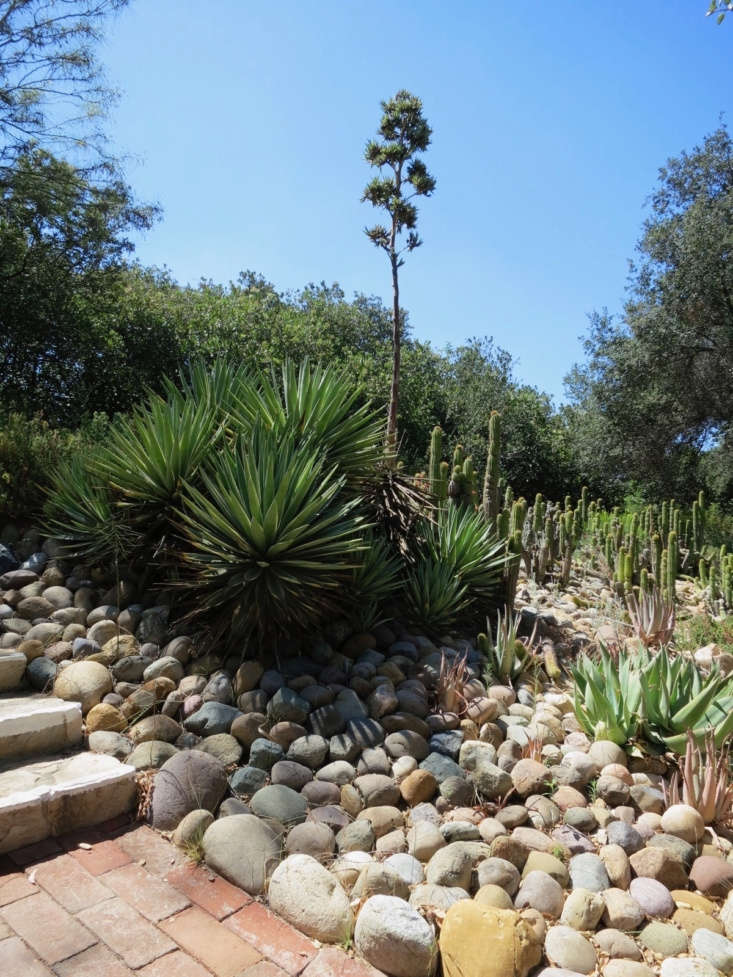Of the two things plants need most—sun and water—Baja California, the narrow Mexican peninsula stretching 760 miles south from California’s southern border, has no shortage of the first.
Water is another matter. The past couple of decades have been exceptionally dry, and both home gardeners and pros must be resourceful in creating and maintaining water-wise landscapes.
To cut down on supplemental irrigation without sacrificing luxuriant growth or aesthetic delight, Baja garden pros like Enrique Ceballos, the maestro responsible for 32 exuberantly cultivated acres at Rancho La Puerta, a legendary wellness resort near Tecate in northern Baja, rely on universal principles of sensible water management and good garden design.
Below, 10 garden tips, gleaned from my tour with Ceballos before the ranch closed to guests in mid-March, that translate to any climate. (Rancho La Puerta will be welcoming guests back as soon as key U.S. and Mexican health milestones are met.)
Photography by Cara Greenberg, unless otherwise noted.
1. Replace thirsty plants.
 Above: This meadow at Rancho La Puerta was once filled with ice plant, a succulent that required supplemental watering. The current field of gaillardia (blanket flower) does not. Photograph courtesy of Rancho La Puerta.
Above: This meadow at Rancho La Puerta was once filled with ice plant, a succulent that required supplemental watering. The current field of gaillardia (blanket flower) does not. Photograph courtesy of Rancho La Puerta.
2. Mulch with rocks.
 Above: Plants that crave very dry conditions, like agave, yucca and cacti, thrive in a bed of gravel or rock. So do cold-tolerant agaves, succulents and woody Mediterranean plants, like lavender, in more northerly climes.
Above: Plants that crave very dry conditions, like agave, yucca and cacti, thrive in a bed of gravel or rock. So do cold-tolerant agaves, succulents and woody Mediterranean plants, like lavender, in more northerly climes.
3. Prioritize natives.
 Above: Plants native to a region require less coddling, and often less water, than imports. In Baja, the list includes artemisia, sages, Mexican primrose, and desert bird of paradise. “Eco-equivalents,” or plants from similar climates in other parts of the world, are next best.
Above: Plants native to a region require less coddling, and often less water, than imports. In Baja, the list includes artemisia, sages, Mexican primrose, and desert bird of paradise. “Eco-equivalents,” or plants from similar climates in other parts of the world, are next best.
4. Be wary of invasives.
 Above: California live oaks struggle to compete with non-native undergrowth at Rancho La Puerta. Pampas grass from Argentina became a problem here, as did the lovely but disease-prone tamarisk tree, brought to the area from Australia in the early-20th century.
Above: California live oaks struggle to compete with non-native undergrowth at Rancho La Puerta. Pampas grass from Argentina became a problem here, as did the lovely but disease-prone tamarisk tree, brought to the area from Australia in the early-20th century.
5. Withhold water from fast growers.
 Above: Japanese wisteria’s purple tendrils look romantic, but the vine can grow 25 feet in a season and become a fearsome thug. Eliminating excess water keeps it blooming but in check. Photograph courtesy of Rancho La Puerta.
Above: Japanese wisteria’s purple tendrils look romantic, but the vine can grow 25 feet in a season and become a fearsome thug. Eliminating excess water keeps it blooming but in check. Photograph courtesy of Rancho La Puerta.
6. Bark is beautiful.
 Above: Make the most of texture by limbing up trees with grooved, peeling, or otherwise interesting bark to expose more of it.
Above: Make the most of texture by limbing up trees with grooved, peeling, or otherwise interesting bark to expose more of it.
7. Blend the garden into its surroundings.
 Above: To seamlessly tie your garden into the larger environment, bring in plants that grow beyond your gate. Chapparal buckwheat and wild currant from the foothills of the mountains surrounding Rancho are also used in the more formal areas.
Above: To seamlessly tie your garden into the larger environment, bring in plants that grow beyond your gate. Chapparal buckwheat and wild currant from the foothills of the mountains surrounding Rancho are also used in the more formal areas.
8. Hardscape with local materials.
 Above: For an unerringly natural look, pave and build garden structures with rock or stone quarried in your vicinity. This water feature at Rancho was constructed of quartz and feldspar from nearby sources.
Above: For an unerringly natural look, pave and build garden structures with rock or stone quarried in your vicinity. This water feature at Rancho was constructed of quartz and feldspar from nearby sources.
9. Mix it up for visual interest.
 Above: Juxtapose plants that vary dramatically in shape and texture, like the massive silvery spikes of Queen Victoria agave against more delicate leaves, to keep your garden from becoming an undifferentiated mass.
Above: Juxtapose plants that vary dramatically in shape and texture, like the massive silvery spikes of Queen Victoria agave against more delicate leaves, to keep your garden from becoming an undifferentiated mass.
10. Punctuate for drama.
 Above: The tall clipped forms of cypress trees at Rancho La Puerta are like exclamation points in the landscape. On a domestic scale, try ilex ‘Sky Pencil,’ a narrow evergreen holly.
Above: The tall clipped forms of cypress trees at Rancho La Puerta are like exclamation points in the landscape. On a domestic scale, try ilex ‘Sky Pencil,’ a narrow evergreen holly.
For more on gardens in dry climates, see: